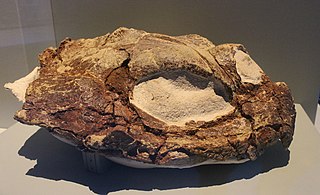
Echinopsis is a large genus of cacti native to South America, sometimes known as hedgehog cactus, sea-urchin cactus or Easter lily cactus. One small species, E. chamaecereus, is known as the peanut cactus. The 128 species range from large and treelike types to small globose cacti. The name derives from echinos hedgehog or sea urchin, and opsis appearance, a reference to these plants' dense coverings of spines.

Cleistocactus is a genus of flowering plants in the cactus family Cactaceae, native to mountainous areas - to 3,000 m (9,843 ft) - of South America. The name comes from the Greek kleistos meaning closed because the flowers hardly open.

Matucana is a genus of cacti, containing approximately 20 species of mostly globular plants. The genus is only known from Peru, mostly along the Marañón River.

Pereskia is a small genus of about four species of cacti that do not look much like other types of cacti, having substantial leaves and non-succulent stems. The genus is named after Nicolas-Claude Fabri de Peiresc, a 16th-century French botanist. The genus was more widely circumscribed until molecular phylogenetic studies showed that it was paraphyletic. The majority of species have since been transferred to Leuenbergeria and Rhodocactus. Although Pereskia does not resemble other cacti in its overall morphology, close examination shows spines developing from areoles, and the distinctive floral cup of the cactus family.

Herdmania is a genus of ascidian tunicates in the family Pyuridae.

A salp or salpa is a barrel-shaped, planktic tunicate. It moves by contracting, thereby pumping water through its gelatinous body, one of the most efficient examples of jet propulsion in the animal kingdom. The salp strains the pumped water through its internal feeding filters, feeding on phytoplankton.

In 1984, the International Organization for Succulent Plant Study set up a working party, now called the International Cactaceae Systematics Group, to produce a consensus classification of the cactus family, down to the level of genus. Their classification has been used as the basis for systems published since the mid-1990s. Treatments in the 21st century have generally divided the family into around 125–130 genera and 1,400–1,500 species, which are then arranged in a number of tribes and subfamilies. However, subsequent molecular phylogenetic studies have shown that a very high proportion of the higher taxa are not monophyletic, i.e. they do not contain all of the descendants of a common ancestor. As of March 2017, the internal classification of the family Cactaceae remained uncertain and subject to change. A classification incorporating many of the insights from the molecular studies was produced by Nyffeler and Eggli in 2010.

Armatocereus is a genus of mostly tree-like cacti from South America. These species have a conspicuous constriction at the end of the annual growth. The flowers are mostly white, with a more or less spiny ovary. The fruits are mostly spiny.

Browningia is a genus of cacti, comprising 11 accepted and 3 unresolved species. It is named for Webster E Browning (1869-1942), director of the Instituto Inglés, Santiago, Chile.

Pilosocereus is a genus of cactus native to the Neotropics. Tree cactus is a common name for Pilosocereus species.

Miqueliopuntia is a monotypic, genus of cactus in the Cactaceae family, containing a single species, Miqueliopuntia miquelii(Monv.) F.Ritter., which is native to the Chilean coasts of South America.

Psephophorus is an extinct genus of sea turtle that lived from the Oligocene to the Pliocene. Its remains have been found in Europe, Africa, North America, and New Zealand. It was first named by Hermann von Meyer in 1847, and contains seven species, P. polygonus, P. calvertensis, P. eocaenus, P. oregonesis, P. californiensis, P. rupeliensis, P. scaldii, and a species discovered in 1995, P. terrypratchetti.

Halocynthia is a genus of ascidian tunicates in the family Pyuridae. Species such as H. roretzi are used as food.

Harrimaniidae is a basal family of acorn worms. A taxonomic revision was undertaken in 2010, and a number of new genera and species found in the Eastern Pacific were described. In this family the development is direct without tornaria larva, and circular muscle fibers in their trunk is missing. There is some indication that Stereobalanus may be a separate basal acorn worm lineage, sister to all remaining acorn worms.

Aplidium is a genus of colonial sea squirts, tunicates in the family Polyclinidae. There are about 188 species in the genus found in shallow waters around the world.
Friedrich Karl Johann Vaupel was a German botanist who specialized in the study of cacti. He was the binomial authority of many species within the family Cactaceae.

Palaeovaranus is an extinct genus of varanoid lizards from the Late Eocene of France and Germany. It contains two species, Palaeovaranus cayluxensis and Palaeovaranus giganteus. The genus was first named by Henri Filhol in 1877, but he had named the species Palaeovaranus cayluxi earlier as Palaeosaurus cayluxi in 1873, and as Necrosaurus cuxleyi in 1876 after it was discovered that Palaeosaurus was preoccupied. However, he failed to provide any kind of valid description, which renders Karl Alfred Ritter von Zittel's 1887 description of the taxon as the valid authority on its validity. Despite this, the name Necrosaurus was the widely used name in the literature afterwards until 2017, when the name Paleovaranus was revived.
Polyzoa is a genus of ascidian tunicates in the family Styelidae. In older literature, Polyzoa was used as the name of the phylum Bryozoa.
Sweetognathus is an extinct genus of conodonts in the family Sweetognathidae that evolved at the beginning of the Permian period, in near-equatorial, shallow-water seas.

Eriosyce paucicostata, the few-ribbed neoporteria, is a species of cactus in the genus Eriosyce, native to southwest Antofagasta in northern Chile. As its synonym Neoporteria paucicostata it has gained the Royal Horticultural Society's Award of Garden Merit.
















